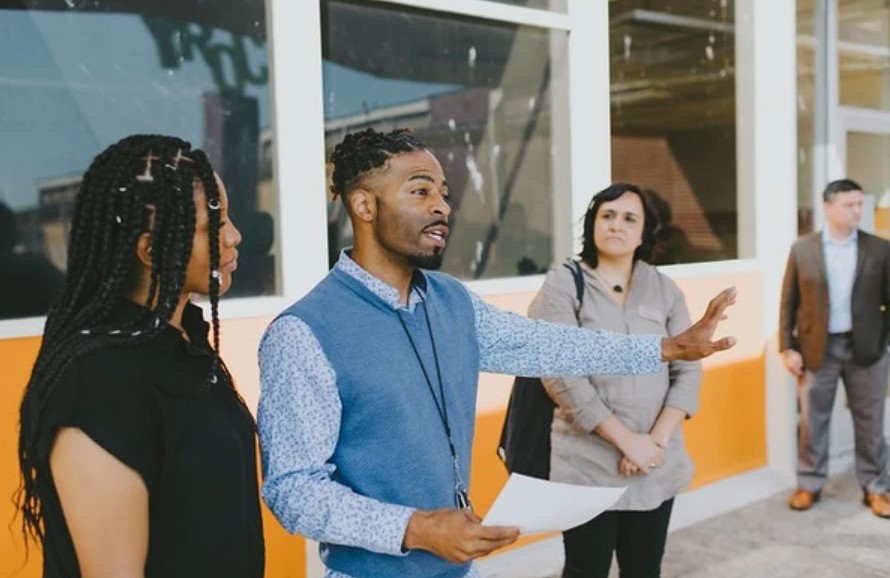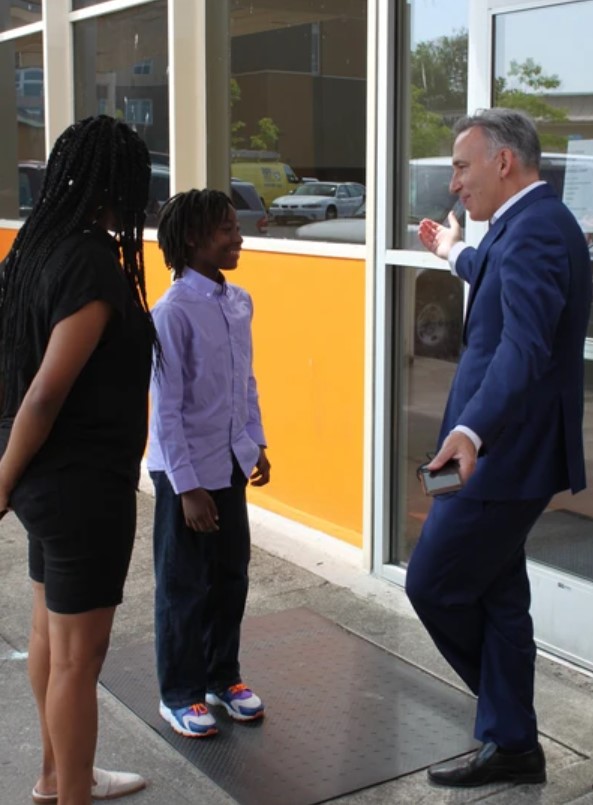Last month, School’s Out Washington led a tour of two of our Best Starts for Kids Out-of-School Time grantees to showcase their exemplary programs. Read Part 1.
In Renton, at the Highlands Neighborhood Center, kids learned about how environmental pollutants enter our water systems (and enthusiastically spraying “rain” all over the model town), filling a room with giggles as they concocted shimmery slime using a recipe written in Spanish, and racing to construct machines out of items like pipe cleaners, tape, and pennies. A testament to how engrossing their activities were, the kids were largely unconcerned with the gaggle of adults in their space.
In South Seattle, at Walk Away City Collaborative, kids are learning the ins and outs of green screen videography so that they could create a short video about rejecting lifestyle choices that would knock them off of their journey to be their true selves. One participant even had the opportunity to talk about his political career aspirations with King County Executive Dow Constantine. It was a jam-packed day of thoughtful, creative youth work.
The type of work funded by the Best Starts Out-of-School Time initiative, which we saw in the afternoon with Walk Away City Collaborative, is People of Color-led organizations. These programs are majority-POC, from leadership to staff and kids served. The strategy upholds that youth need to be supported in enriching, culturally relevant spaces: we know that there are quantifiable benefits to youth interacting with educators that look like them, and it’s also crucial to positive social-emotional development.
Our caravan arrived at the Othello Youth Center to visit Walk Away City Collaborative, where we were joined by Yolanda McGhee, who oversees the Best Starts Trauma-Informed and Restorative Practices initiative that also funds Walk Away. Michael and Cedrecia Passian, the founders and leaders of the organization, greeted us outside of the Othello Youth Center and described the program model, and the impact that Best Starts Out-of-School Time funding had. “I knew what I wanted to do, but this was just an idea in my head. The funding made it real,” Michael said.

Walk Away’s Middle School University program pays kids stipends for their attendance and engagement in the program, which features career exploration, hands-on learning, field trips, and recreation activities. Participants also get financial literacy education through Key Bank to help build money management skills. Another important outcome of the Best Starts Out-of-School Time investment is the organization’s van, which ensures that kids can safely get to and from the program. Transportation is a fundamental barrier that many grants don’t account for, but the holistic design of this initiative recognizes that more and better programming won’t benefit kids if they can’t get in the building. Because of this vital resource, the room inside is packed with kids.
The guest that day was local videographer Hal Raines, who set up a veritable studio set up in the program space. Two kids were standing in front of a green screen, two were stewarding the video cameras, and another one was flitting around taking photographs. The two on camera were being interviewed about their experience at Walk Away. In reference to the partnership the organization has with City Fruit and their workforce education on agriculture and arboriculture, one boy said, “Last year, I didn’t know anything about pruning. Now my neighbor is paying me for my time!”

Periodically, kids would pass the equipment to someone else in the room, rotating who got a chance to try it out. Hal was talking through his fiddling with buttons and cables, describing how the green screen worked and how effects could be added. On a monitor above his set-up, the final product was visible: the kids on camera had been digitally put in front of a glimmering cityscape. All of this was preparation for the project of the day when they were going to shoot a video and add digital effects to show a kid being tempted by destructive choices. But they wanted to highlight the determination to walk away from choices like substance use and violence and towards their futures, where they could be and do anything.
One boy already knows what he will do when he gets older. He’s going to be a Senator and wears a button-up shirt every day to prepare. When an opportunity arose, Cedtrecia led him outside to talk about his aspirations with Executive Constantine. They talked shop for a while, and Executive Constantine recommended he apply for the Page Program with the Washington State Legislature to kick-start his political experience. After a farewell handshake, the boy went back inside, stifling a grin.
The day was a whirlwind of testimonials and statistics but was also an invaluable opportunity for decision-makers to experience first-hand the programs they’ve helped grow. SOWA was excited to be able to lift up the work of members of both funding models and show the magic that can uniquely happen as a part of each strategy. We left the day with a renewed sense of gratitude and determination. It’s no small task to participate in such a ground-breaking, innovative project, and we’re glad to be in partnership with King County to support such remarkable programs.
